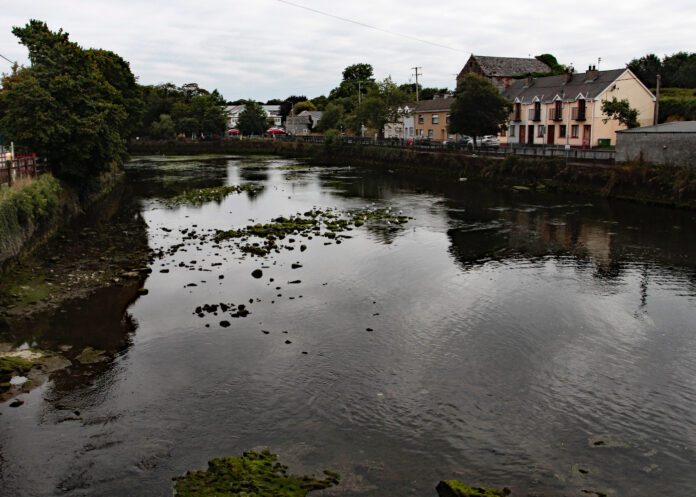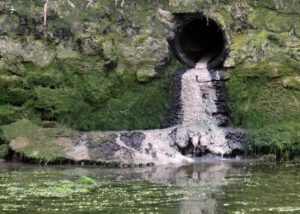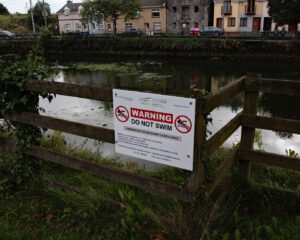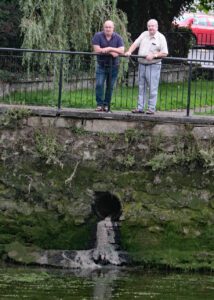
A substandard sewage system, which pumps raw sewage into the River Deel, and onto the Main Street and footpaths in Askeaton, Co Limerick, is not likely to be rectified until after 2025, the Limerick Post has learned.
It comes as a group of local politicians have asked Limerick City and County Council to take legal action against Irish Water and the Environmental Protection Agency (EPA), claiming the two state bodies have failed to deal, with what Cllr Kevin Sheehan described as “a public health scandal”.
The former mayor of the city and county, who has raised the issue for over 30 years, said the situation has worsened in recent years due to “increased rainfall” forcing open manhole covers an expelling waste into the river and the town.
Videos of what is claimed is raw sewage pouring into the River Deel have also recently floated on social media.

The Pollution on the River Deel, Askeaton
Picture brendan Gleeson
Irish Water has acknowledged there is a problem, and said that it hopes to provide a solution, but it could not give a date for this.
The Limerick Post has learned the EPA opened a “compliance file” on Irish Water in 2014, relating to delays in upgrading the Askeaton project, and that, in its last response to the EPA, on March 31, 2020, Irish Water stated: “Having regard to current funding constraints, there is unlikely to be any significant spend on the Askeaton scheme before 2025 as it is not included in the 2020 -2024 Business Plan (RC3).”
Cllr Sheahan said: “The River Deel is poisoned. The Council has tested the water in several places and the river in Askeaton has very high levels of E.coli. I grew up on the river, I fished it, swam it, and took boat rides — the River Deel was our playground — but now it’s polluted.”

The Pollution Warning Signs on the River Deel, Askeaton, County Limerick
Picture brendan Gleeson
“Our sewage system is overflowing in Askeaton. We have an outdated single pipe system of storm drain water and sewage, and it needs to be upgraded.”
“When we get this extraordinary heavy rain, it causes the manhole covers in the town to pop, and it results in sewage coming up onto the streets and footpaths.”
He claimed Irish Water, the EPA, and Limerick City and County Council have all failed to address the issue over years, however Cllr Sheehan praised the Council’s maintenance staff for their rapid responses to the rotten eruptions in the town.
“The fish are not in the river anymore. There hasn’t been one single massive fish kill, but more a gradual process that is eliminating fish-life and bird-life.”
Cllr Sheahan said his calls “over thirty years” for an adequate sewage system have “fallen on deaf ears, especially since Irish Water came into existence.”
Council spokespersons directed this author to Irish Water for comment.
“I’ve visited the site where sewage reaches the riverbank. It used to go into settlement beds which were built before the 1940s — that was sufficient for the then population, but the population in Askeaton has more than trebled.”
“The beds are no longer effective, and with the pressure of the water running down the overflow pipes, (sewage) gets diverted into the river, and I can see ‘solids’ flowing into the river.”
“No member of officialdom from any state organisation has ever asked me to show them where exactly it is, because they know exactly where it is.”
“The state has failed to fund the provision of an up-to-date sewage treatment plant. Now they draw away tanks of sewage to be treated elsewhere. But, when we get excess rainwater, the tank fills at least twice as quickly.”
Cllr Sheahan claimed that prior to the merger of Limerick County Council and Limerick City Council, the EPA erected warning notices at the site of sewage entering the Deel, warning Limerick County Council that it would be fined up to €1,000 weekly if it did not rectify the problem then.

Jimmy O’Donoghue, Askeaton Swimming Club and Cllr Kevin Sheahan, Chair pf the Adare/Rathkeale Municipal District, shocked at the Pollution on the River Deel, Askeaton, County Limerick
Picture brendan Gleeson
However, the Independent councillor claimed the EPA has never followed through on this: “When Irish Water came into existence, that notice disappeared, and it’s now in excess of one month since I looked for a copy of the notice from the (Council) files, and I haven’t yet been provided with it.”
Fine Gael councillor Adam Tesky has proposed the joint local authority issue legal proceedings against Irish Water and the EPA.
“Enough is enough at this stage, we have raw sewage evidently entering the river in very large amounts and it cannot continue, and our representations to date have fallen on deaf ears,” Cllr Tesky said.
“Therefore, I have directed Limerick City and County Council to issue legal proceedings against Irish Water and the EPA in order to hold them accountable and responsible for what is happening in Askeaton, before a catastrophe happens,” added Cllr Tesky.
He described pollution in the Deel as “off the Richter scale”.
“If it was a private citizen, particularly a farmer, and the Council has been pestering farmers for some time in relation to management of effluent discharge – and rightly so in some cases – however if the farmer doesn’t act responsibly they will take a portion of his single farm payment off him, and yet these established state bodies are able to get away with blue murder,” Mr Tesky went on.
Limerick barrister, and Independent councillor Emmett O’Brien, who has backed Cllr Tesky’s proposal, said: “It’s an affront to people in Adare Rathkeale area that raw sewage is entering the River Dell, and the River Shannon in Glen, and in this day and age when you see the amount of public money that is being wasted by the state, and that we don’t have proper sewage systems, it needs to be addressed as a matter of urgency.”
Cllr Sheahan said the pollution was “a public health scandal”, adding, “the HSE has advised the Council to put up notices where the water is not suitable for bathing, and those notices are up now”.
“We have young people wanting to learn how to row and there are grants available to buy small boats and that’s a very admirable thing to be teaching our youth, but if any of our kids fall into the water — that water is seriously contaminated,” Cllr Sheahan warned.
“These two state bodies have, at least through negligence, failed to do what needs to be done. We have had it long enough; There is money for freeways and walkways and runways and we cannot get money to install, in what is the oldest town in the county and a historical town which we are dong everything we can to try to promote tourism, a sewage system,” Cllr Sheahan said.
He claimed Irish Water has objected to additional connections to the Askeaton sewage system, “which is an admission in itself that it has at least reached its capacity, but of course it has far since reached it and exceeded it”.
In a letter sent to Independent TD Richard O’Donoghue spokesman for the Limerick Deel Anglers club, John O’Keeffe, said they had received a video of “raw effluent flowing freely” from a pipe into the river.
“Is there any point in us as a club trying to lobby to get a river back up and running as a fishery, when the likes of this is allowed to happen on a very regular basis?,” wrote Mr O’Keeffe.
“As a founding member of the West Limerick Deel Anglers we feel let down by the governing bodies whose job it is to protect our waterways,” he added.
“The time for action has to begin, and, as a club, we are asking three questions: Who is accountable? Will they face a fine or punishment? Thirdly, when is this problem that is ongoing for a long time, going to be sorted?,” he asked.
Deputy O’Donoghue told the Limerick Post he has raised the issue in the Dail and is supporting Councillor’s call for legal action.
“Cllr Kevin Sheahan has been highlighting this for 32 years. The biggest polluter in Ireland are local authority infrastructure for sewage systems and this is because of a lack of funding from government and false promises from minister after minister promising sewage systems for different areas and they haven’t fulfilled their promises,” Deputy O’Donoghue said.
“The buck stops with Irish Water and the Council,” he added.
An Irish Water spokesman replied: “Irish Water acknowledges the challenges with the Askeaton Waste Water Treatment Plant. We continue to work with Limerick City & County Council to manage the plant and network to ensure it is operating at its optimum capacity.”
The spokesman said the company has completed “a preliminary design” for a wastewater treatment plant in Askeaton, but he added that “the delivery timelines for the Askeaton Wastewater Treatment Plant cannot yet be confirmed”.
The company also acknowledged “there have been some uncontrolled releases from both the network and the waste water pumping station at Askeaton, the most recent incident occurred last weekend where Limerick City & County Council’s jetting contractor removed significant amounts of wipes, rags, etc. from the network”.
“These materials contributed significantly to the overflows that occurred. Irish Water have been extremely proactive in advising customers of the issues that flushing such items can have on the network,” the spokesman said.
The “Think Before You Flush” campaign aims to highlight the problems that some items can cause to the plumbing in our homes, neighbour’s homes, wastewater network and marine environment when they are flushed down the toilet.
“Recently almost one million adults living in Ireland admit to regularly flushing wet wipes and other sanitary items down the toilet. Only the 3 Ps, pee, poo and paper should be flushed down the toilet. All other items including wet wipes and other sanitary products should go in the bin even if they are labelled as flushable.”
A spokesperson for Limerick City and County Council said it was Irish Water’s “responsibility to answer media queries on this issue”.
An EPA spokeswoman replied: “Irish Water are required under their Waste Water Discharge Licence (D0315-01) to provide a new waste water treatment plant for the Askeaton agglomeration. Irish Water has not provided the new treatment plant to date.”
The EPA spokeswoman said it had opened a “Compliance Investigation file” on Irish Water’s Askeaton Licence on the 18th of March 2014, “in relation to the delays in providing the new plant”.
“The latest response Irish Water has provided to the EPA (on 31st March 2020) on progress with the Askeaton plant, is that: “Irish Water wish to advise the Agency of the following status update on the Askeaton scheme. Having regard to current funding constraints, there is unlikely to be any significant spend on the Askeaton scheme before 2025 as it is not included in the 2020 -2024 Business Plan (RC3).”
Irish Water’s told the EPA that, following “a review of portfolio of projects and programmes in our Investment Plan, the delivery timelines for Askeaton WWTP upgrade cannot yet be confirmed”.
Irish Water argued that its “building, repair and upgrading of Irish Water’s water treatment plants, wastewater treatment plants, water and sewer network will require a multi-billion euro investment programme over many years”.
Irish Water informed the EPA it was “committed to providing a safe and reliable water supply, protecting the environment and supporting the growth of homes and businesses”.
However, the EPA spokeswoman said: “It is Irish Water’s responsibility to construct a new waste water treatment plant (WWTP) and ancillary works at this site. The management of this work is under Irish Water’s control, so Irish Water is best placed to outline the specific reasons for these delays.”
“The EPA will continue to monitor the operation of the existing WWTP to ensure that the current infrastructure is being operated as efficiently and effectively as possible pending the construction of the new treatment plant.”










